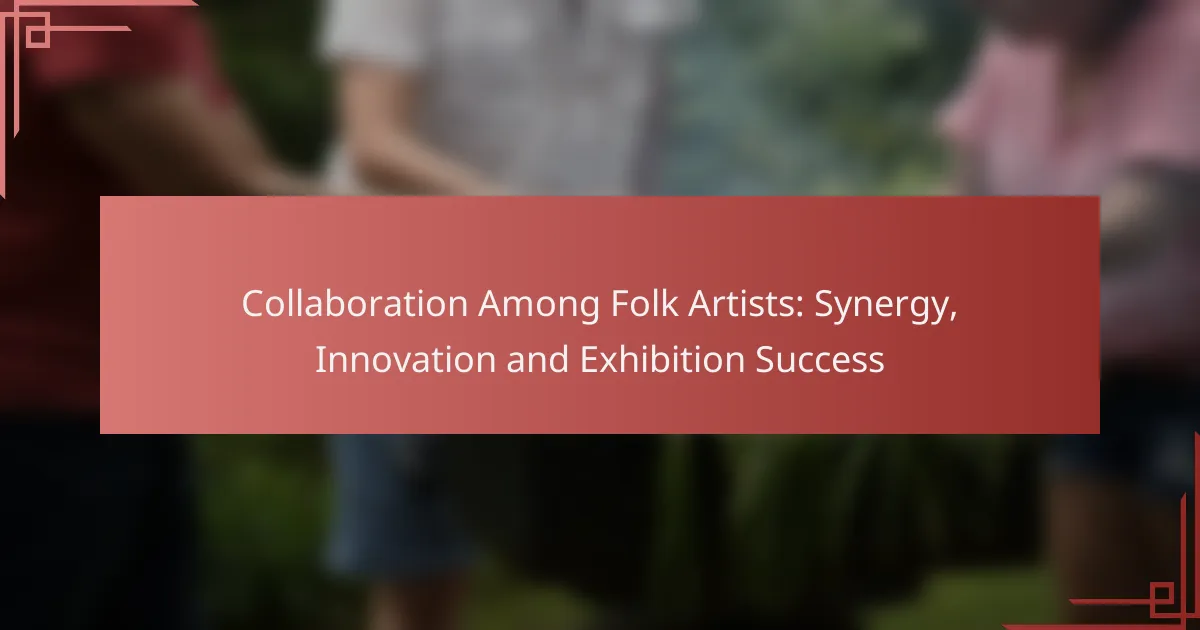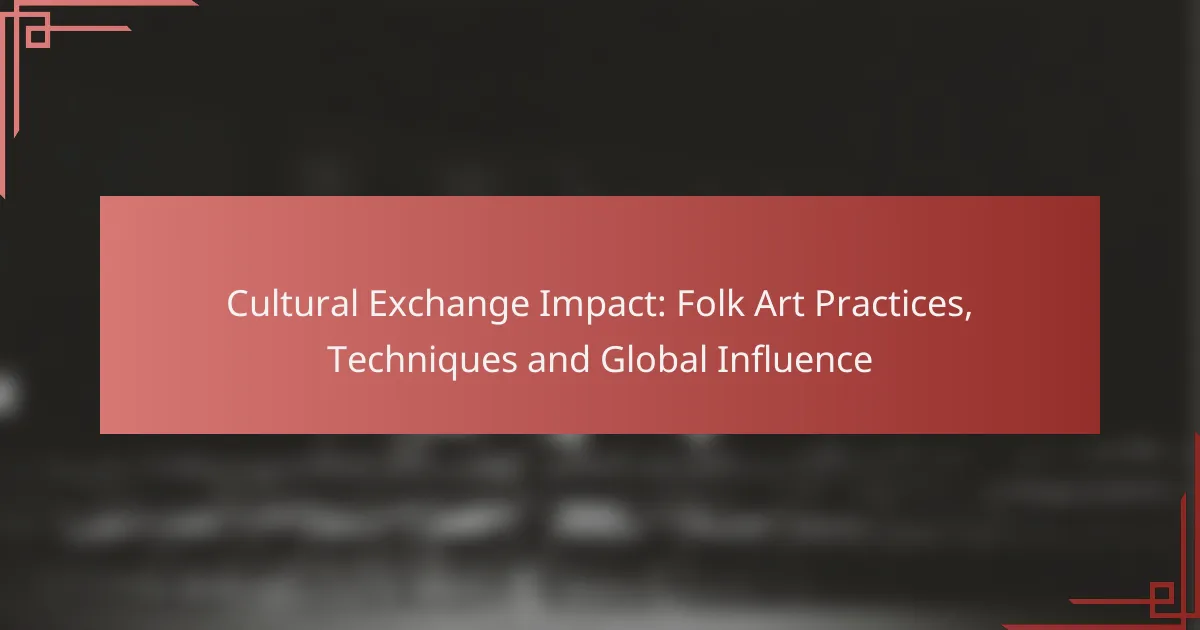Collaboration among folk artists plays a crucial role in enhancing exhibitions by fostering creativity and expanding audience reach. By combining their unique perspectives and skills, artists can create innovative displays that captivate attendees and strengthen community connections. Embracing digital platforms and multimedia integration further enriches the collaborative process, leading to a more vibrant and successful artistic environment.

How can collaboration enhance folk art exhibitions in the United States?
Collaboration can significantly enhance folk art exhibitions in the United States by fostering creativity, expanding reach, and enriching the overall experience for attendees. When artists work together, they can combine their unique perspectives and skills, leading to innovative displays that attract larger audiences.
Increased audience engagement
Collaborative exhibitions often draw more visitors by offering diverse artistic expressions and interactive experiences. For instance, when multiple artists showcase their work together, it creates a vibrant atmosphere that encourages attendees to explore and engage with various art forms.
To maximize audience engagement, consider incorporating live demonstrations or workshops where visitors can participate in the creative process. This hands-on approach not only captivates attendees but also fosters a deeper appreciation for folk art.
Shared resources and knowledge
Collaboration allows folk artists to pool their resources, such as materials, tools, and exhibition spaces, which can reduce costs and increase efficiency. By sharing knowledge, artists can learn new techniques and gain insights into different cultural practices, enriching their own work.
For example, a group of artists might collaborate on a community project, where each member contributes their expertise in a specific medium. This not only enhances the quality of the artwork but also builds a supportive network that can lead to future collaborations.
Cross-promotion opportunities
When artists collaborate, they can leverage each other’s audiences through cross-promotion, significantly increasing visibility for their work. This can be achieved through social media campaigns, joint press releases, or shared exhibition events that highlight each artist’s contributions.
To effectively cross-promote, artists should coordinate their marketing strategies and create cohesive messaging that resonates with both of their audiences. This approach can lead to a mutually beneficial relationship, expanding each artist’s reach and enhancing the overall success of the exhibition.
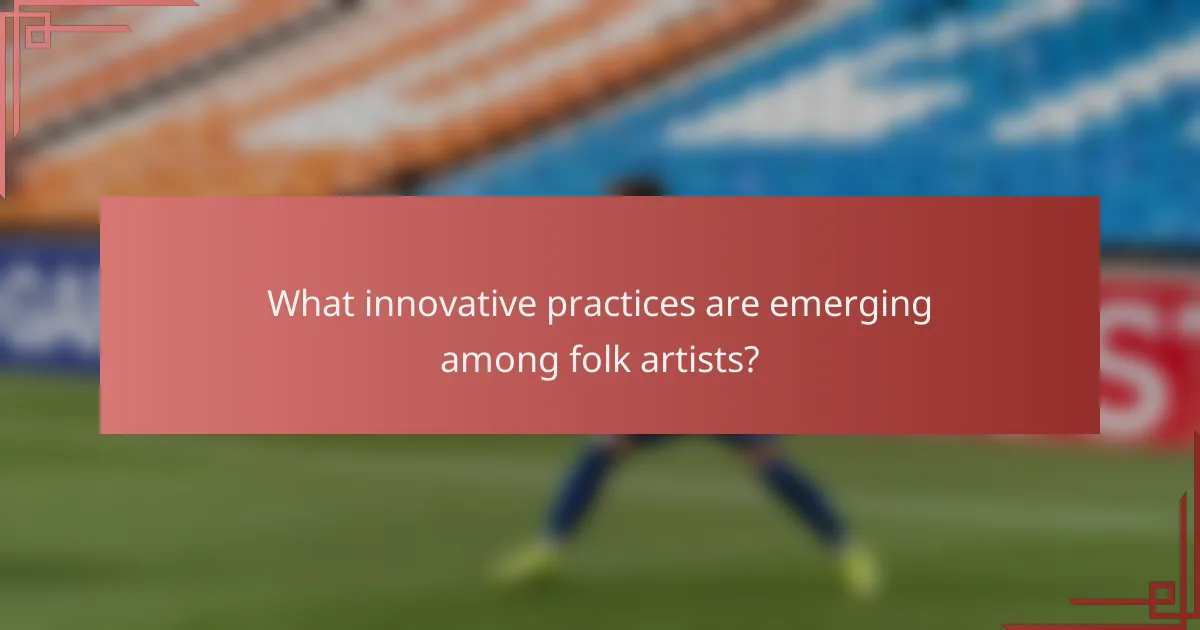
What innovative practices are emerging among folk artists?
Folk artists are increasingly adopting innovative practices that enhance collaboration, creativity, and exhibition success. These practices include leveraging digital platforms, integrating multimedia into traditional art forms, and engaging in community-driven projects.
Use of digital platforms for collaboration
Digital platforms have transformed how folk artists collaborate, allowing them to connect with peers across the globe. Tools like social media, online galleries, and collaborative software enable artists to share ideas, techniques, and resources in real-time.
For example, artists can use platforms like Instagram or Facebook to showcase their work and receive instant feedback, fostering a sense of community. Additionally, virtual workshops and webinars provide opportunities for skill-sharing and networking without geographical constraints.
Integration of multimedia in traditional art
Folk artists are increasingly blending traditional techniques with multimedia elements, creating innovative art forms that resonate with contemporary audiences. This integration can include video, sound, and digital imagery, enriching the storytelling aspect of their work.
For instance, a traditional textile artist might incorporate video projections of their weaving process into an exhibition, offering viewers a deeper understanding of their craft. This fusion not only attracts a wider audience but also revitalizes traditional art forms, making them relevant in today’s digital age.
Community-driven projects
Community-driven projects are vital for folk artists, as they foster collaboration and strengthen local ties. These initiatives often involve local residents in the creative process, resulting in art that reflects the community’s identity and values.
Examples include mural projects that engage local artists and residents in design and execution, or festivals that showcase folk art while providing a platform for emerging artists. Such projects not only enhance community spirit but also promote cultural heritage, ensuring that traditional practices are preserved and celebrated.
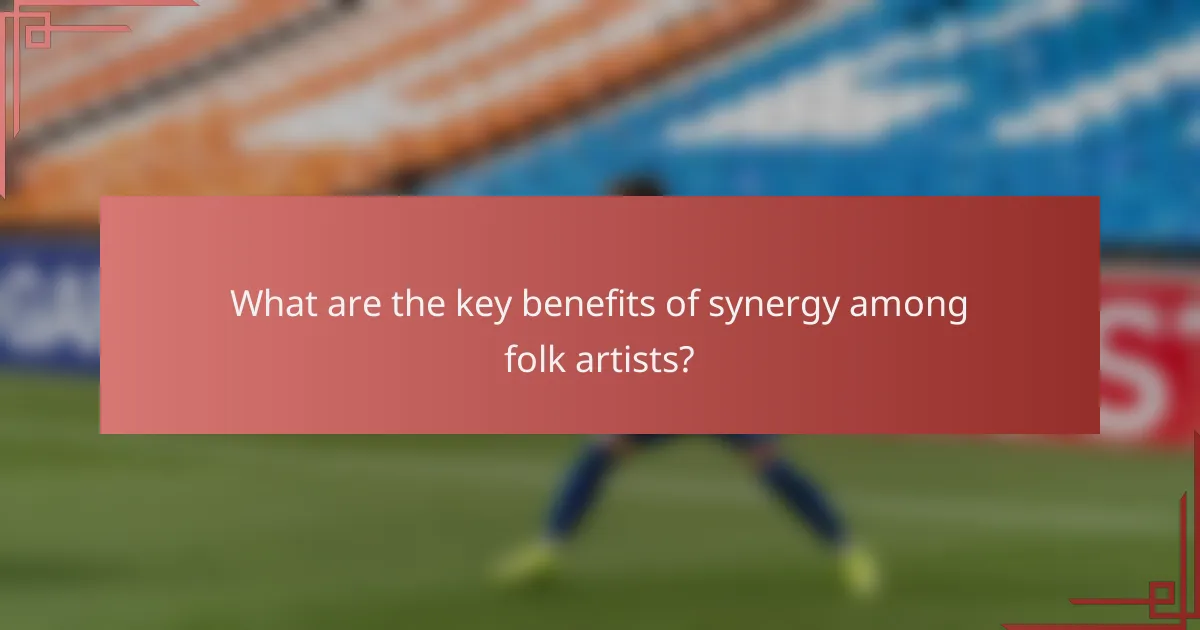
What are the key benefits of synergy among folk artists?
Synergy among folk artists leads to enhanced creativity, stronger community connections, and increased funding opportunities. By collaborating, artists can share ideas, resources, and support, which ultimately fosters a more vibrant artistic environment.
Enhanced creativity and inspiration
Collaboration among folk artists often sparks new ideas and innovative approaches to traditional art forms. When artists come together, they can blend different techniques and styles, leading to unique creations that may not have emerged in isolation.
For example, a group of musicians might combine elements from various cultural backgrounds to create a fusion genre, enriching their artistic expression. This cross-pollination of ideas can inspire individual artists to explore new themes and methods in their work.
Stronger community ties
Working together helps folk artists build stronger relationships within their communities. These connections can lead to a supportive network where artists share resources, promote each other’s work, and collaborate on projects that benefit the local culture.
Participating in joint exhibitions or community events can enhance visibility and foster a sense of belonging among artists. This communal spirit not only strengthens individual careers but also enriches the cultural fabric of the area.
Increased funding opportunities
Collaboration can open doors to new funding sources for folk artists. When artists unite for a common project, they can apply for grants and sponsorships that may be unavailable to individuals. Many funding organizations prefer to support collaborative efforts that demonstrate community impact.
Artists should consider pooling their resources to create larger-scale projects, which can attract more attention and funding. Additionally, showcasing collaborative works at festivals or exhibitions can draw interest from potential investors and patrons, leading to greater financial support.
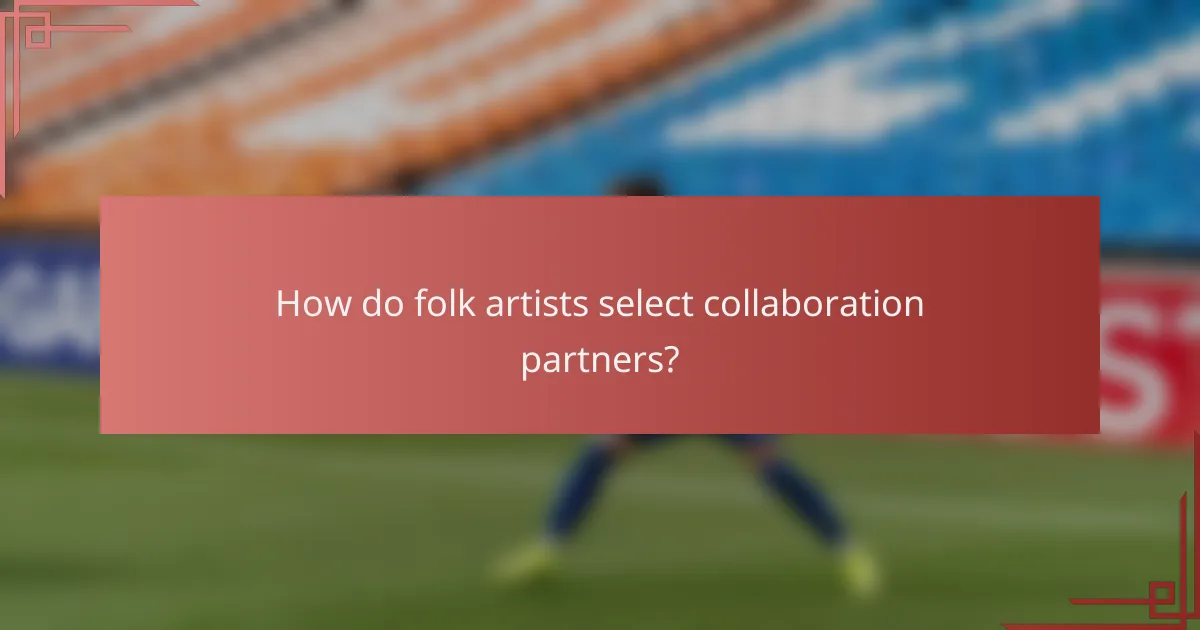
How do folk artists select collaboration partners?
Folk artists typically select collaboration partners based on shared artistic goals, complementary skills, and geographical proximity. These factors help ensure a productive partnership that enhances creativity and leads to successful exhibitions.
Shared artistic vision
A shared artistic vision is crucial for collaboration among folk artists. When partners have aligned goals and themes, their combined efforts can create a cohesive body of work that resonates with audiences. For example, artists focusing on traditional storytelling may collaborate to produce a performance that highlights their cultural narratives.
To assess shared vision, artists should discuss their inspirations, values, and desired outcomes early in the partnership. This dialogue can help identify common ground and set the stage for a successful collaboration.
Complementary skills and styles
Complementary skills and styles enhance the collaborative process by allowing artists to contribute their unique strengths. For instance, a textile artist might team up with a musician to create an immersive experience that combines visual and auditory elements. This synergy can lead to innovative works that neither artist could achieve alone.
Artists should evaluate each other’s techniques and styles to ensure they can effectively support one another. A checklist of skills and artistic approaches can help in identifying potential partners who can fill gaps or bring new perspectives to the project.
Geographic proximity
Geographic proximity can significantly influence collaboration among folk artists. Being located near each other facilitates regular meetings, brainstorming sessions, and hands-on collaboration, which can strengthen the partnership. For example, artists in the same city may find it easier to share resources and participate in local exhibitions together.
While technology allows for remote collaboration, artists should consider the benefits of in-person interactions. If possible, choosing partners within a reasonable travel distance can enhance communication and foster a stronger creative bond.
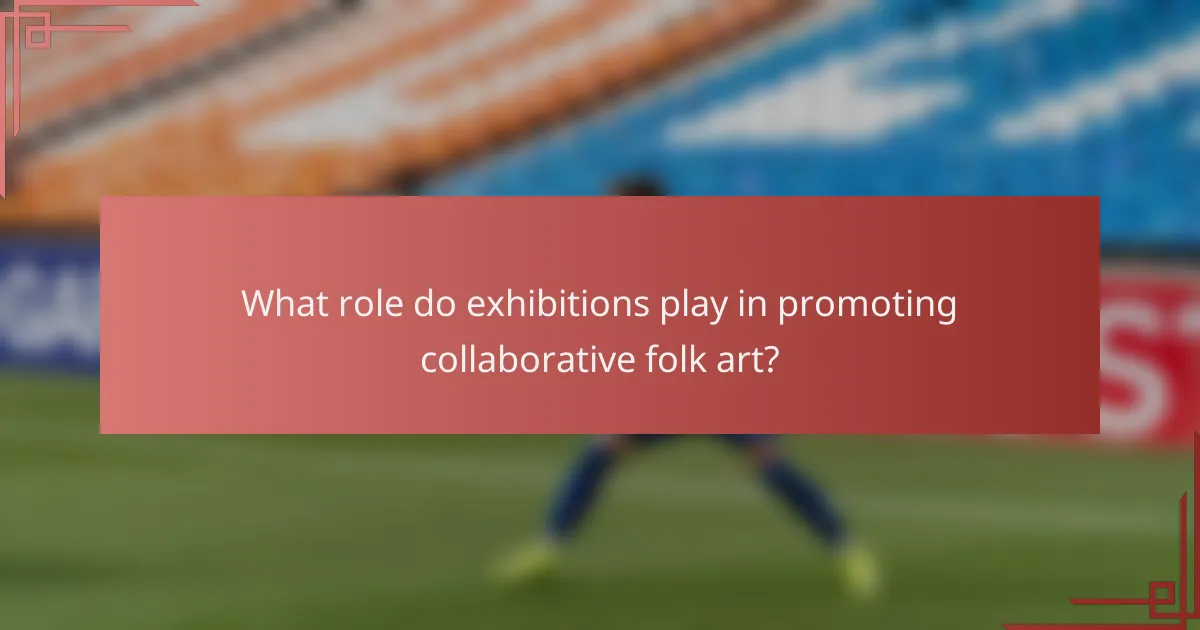
What role do exhibitions play in promoting collaborative folk art?
Exhibitions are crucial for promoting collaborative folk art as they provide a platform for artists to showcase their work and engage with the public. These events foster creativity and innovation by bringing together diverse artistic expressions, attracting wider audiences, and facilitating networking opportunities among artists and art enthusiasts.
Showcasing diverse artistic expressions
Exhibitions allow folk artists to present a variety of styles and techniques, highlighting the richness of cultural heritage. By displaying collaborative works, they emphasize the blending of different traditions and perspectives, which can lead to innovative art forms that resonate with a broader audience.
For example, a joint exhibition featuring artists from various regions can showcase unique crafts, textiles, and performances, each representing distinct cultural narratives. This diversity not only enriches the exhibition but also educates attendees about the multifaceted nature of folk art.
Attracting wider audiences
Exhibitions serve as a magnet for diverse audiences, drawing in individuals who may not typically engage with folk art. By incorporating interactive elements, workshops, and live demonstrations, these events can captivate visitors of all ages and backgrounds.
Promotional strategies, such as social media campaigns and partnerships with local organizations, can further enhance visibility. For instance, collaborating with schools or community centers can encourage family attendance, expanding the reach of folk art beyond traditional circles.
Facilitating networking opportunities
Exhibitions create valuable networking opportunities for artists, curators, and art enthusiasts. They provide a space for artists to connect, share ideas, and collaborate on future projects, which can lead to innovative works that might not emerge in isolation.
Attendees can also meet potential patrons, sponsors, or collaborators, fostering relationships that support the sustainability of folk art. Engaging in discussions during exhibitions can open doors to grants, commissions, or joint ventures, enhancing the overall ecosystem of folk art.
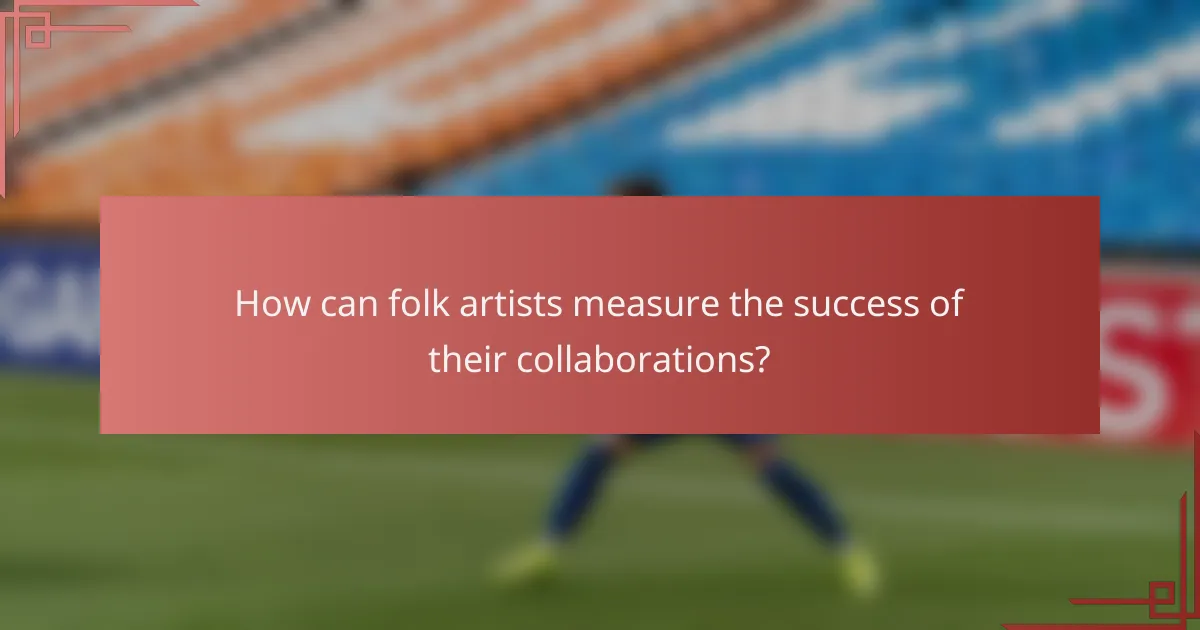
How can folk artists measure the success of their collaborations?
Folk artists can measure the success of their collaborations through various qualitative and quantitative metrics. Key indicators include audience engagement, sales figures, and the impact on their artistic development.
Audience Engagement
Audience engagement is a crucial metric for assessing collaboration success. This can be gauged through attendance at joint exhibitions, social media interactions, and feedback from attendees. High levels of engagement often indicate that the collaboration resonates with the audience.
Artists can track engagement through surveys or by monitoring online platforms. For instance, a significant increase in followers or shares on social media can reflect a successful partnership.
Sales and Revenue
Sales figures provide a concrete measure of collaboration success. Artists should analyze the revenue generated from joint projects, such as exhibitions or merchandise. Comparing sales before and after a collaboration can reveal its financial impact.
For example, if a collaborative exhibition results in a 20-30% increase in sales compared to previous solo shows, this indicates a successful partnership. Artists can also consider the cost of production versus revenue to assess profitability.
Artistic Growth
Artistic growth is a more subjective but equally important measure of collaboration success. Artists should reflect on how their skills and creative approaches have evolved through collaboration. This can include new techniques learned or fresh perspectives gained from working with others.
Keeping a journal or portfolio that documents changes in style or technique can help artists evaluate their growth over time. Regular discussions with collaborators can also provide insights into mutual artistic development.
